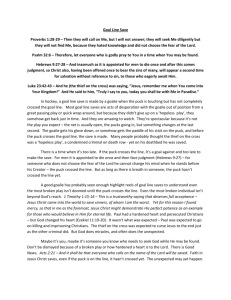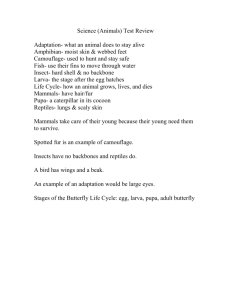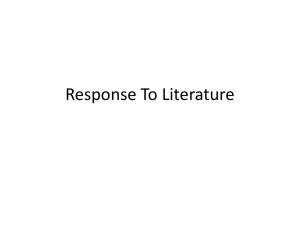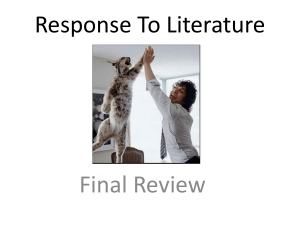Goaltending Principles 101…
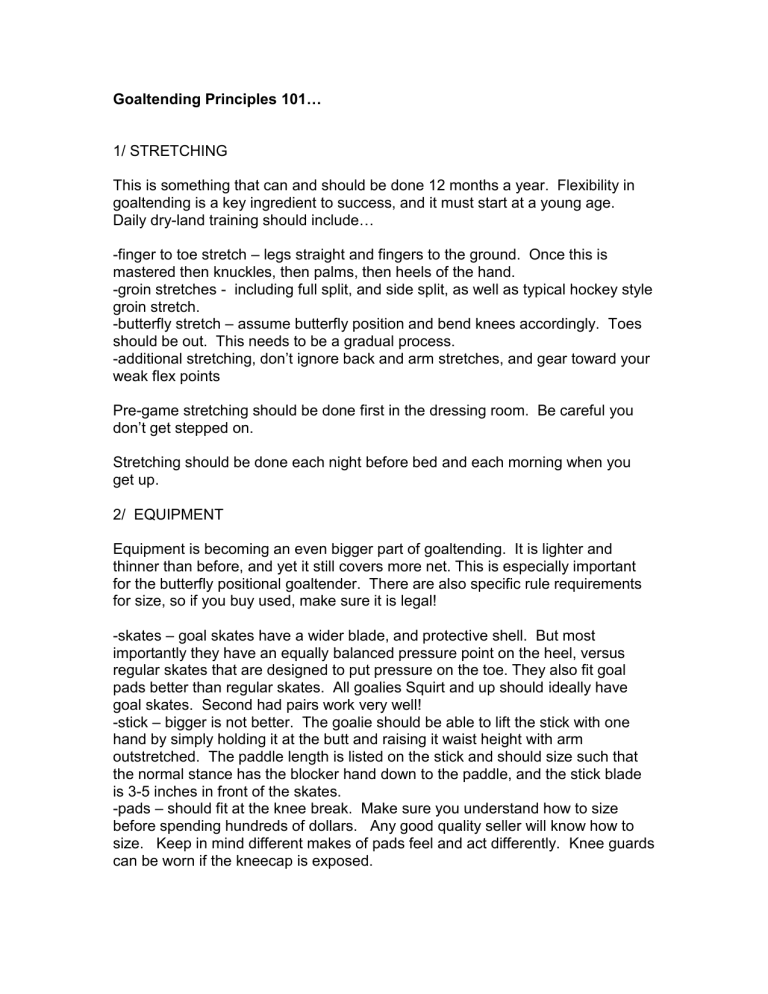
Goaltending Principles 101
…
1/ STRETCHING
This is something that can and should be done 12 months a year. Flexibility in goaltending is a key ingredient to success, and it must start at a young age.
Daily dryland training should include…
-finger to toe stretch – legs straight and fingers to the ground. Once this is mastered then knuckles, then palms, then heels of the hand.
-groin stretches - including full split, and side split, as well as typical hockey style groin stretch.
-butterfly stretch
– assume butterfly position and bend knees accordingly. Toes should be out. This needs to be a gradual process.
additional stretching, don’t ignore back and arm stretches, and gear toward your weak flex points
Pre-game stretching should be done first in the dressing room. Be careful you don’t get stepped on.
Stretching should be done each night before bed and each morning when you get up.
2/ EQUIPMENT
Equipment is becoming an even bigger part of goaltending. It is lighter and thinner than before, and yet it still covers more net. This is especially important for the butterfly positional goaltender. There are also specific rule requirements for size, so if you buy used, make sure it is legal!
-skates – goal skates have a wider blade, and protective shell. But most importantly they have an equally balanced pressure point on the heel, versus regular skates that are designed to put pressure on the toe. They also fit goal pads better than regular skates. All goalies Squirt and up should ideally have goal skates. Second had pairs work very well!
-stick – bigger is not better. The goalie should be able to lift the stick with one hand by simply holding it at the butt and raising it waist height with arm outstretched. The paddle length is listed on the stick and should size such that the normal stance has the blocker hand down to the paddle, and the stick blade is 3-5 inches in front of the skates.
-pads – should fit at the knee break. Make sure you understand how to size before spending hundreds of dollars. Any good quality seller will know how to size. Keep in mind different makes of pads feel and act differently. Knee guards can be worn if the kneecap is exposed.
-gloves
– don’t get them too big. Don’t settle for catching gloves that don’t have a well developed pocket.
-neck guard and cup – get special goaltender equipment. The neck guard shield does not replace the need for a neck guard underneath. Both are important.
-mask – vision, safety and comfort are the key requirements. Looks don’t matter.
-chest protector – use one big enough to help cover the net in butterfly situations, but one that doesn’t impede movement. Gloves need to fit over or work well with the sleeves.
Goalies need to be responsible with their equipment. The most important rule –
If it smells and it can be washed, wash it. If your pads and gloves smell, then you have not aired them out properly. Fan dry gloves after each use!
3/ STYLE
I strongly advocate the butterfly style as it better matches up with today’s improved shooters. Not only has shooting accuracy improved, but puck speed has as well. In addition, the chances to excel as a goaltender are much better with this approach, in my opinion, The reaction goaltender can be exceptional, but requires very specific skill sets that are frankly hard to find.
The butterfly can have mixed results at an early age as the player is so small that the top half of the net is exposed. In addition, young goaltenders are not as mobile and cannot rise quickly. However, if a player is too far along it is increasingly difficult to teach the butterfly style. A good butterfly goaltender reacts on taught situations with “programmed” movement, and this needs to be ingrained early.
One concept of the butterfly style is to take away the bottom half of the net from the shooter. Once this is done, the goaltender can react to the shot focusing primarily on the top half. Many pros are also adept at leaving a large “5 hole” open, and then closing it down. However, the use of the butterfly is not automatic, unless the shooter is within about 15 feet (varies somewhat by age).
Outside of this the goaltender must react to the shot and learn when to go down and when to remain on his feet. Generally speaking, a goaltender on his feet has more options open and can better react to certain situations. However, coaches must not automatically assume that the goalie should “stand up”. In fact, most situations need to be looked at individually.
Another core advantage of the butterfly is the position specific movement that very efficiently allows them to face new situations while remaining in an optimal position to make the save. ie. They are not laid out flat on their side or belly or back (normally)!.
A proper style also means playing into the strengths of the goaltender. For example, a goaltender with a quick glove hand can intentionally play stronger to
the stick side. A goaltender with quick feet can take more risk by playing the puck more, and cutting more angle. Find out what you are good at and use it.
Some key points for the new goalie…
stick on ice far enough ahead that pads won’t land on them, but close enough that the puck won’t jump over. In the butterfly the stick moves out and at more of an angle, so the puck can end up over the stick, but it must be at such an angle that the puck moves up into the belly for no rebound.
a wide enough “V” that the corners get covered but the 5 hole shuts down.
Not so wide that the rebound is out in front of the play.
butt is up, not sitting down
shoulders forward but balanced
gloves in front where peripheral vision can see them. Should be just off the knees, not high in the sky
eyes forward, and always leading the direction of the body.
position/angling such that you always face the play. Do not “butt-over” to get to where you want to be.
4/ ATTRIBUTES of GREAT GOALTENDERS
Angles - Angles are relatively easy to teach but difficult for some goaltenders to utilize properly. This is not because they don’t understand, but usually either because they don’t read the play quickly enough to be in the right spot, or they are a little afraid to take a chance. A key to good angle play is good skating technique. No matter what style the goalie uses, playing the angles properly is a key weapon. Time needs to be spent to review the angle play in the following situations… breakaway
2 on 1 circle and out with good defensive pressure blue line clear shot blue line with a screen blue line with opposition on the doorstep
Quick Feet - Goalies need to follow the puck with their eyes and move with their feet. Drills include… simple pipe to pipe several times shooter tries to score from behind the net pass from corner to high slot, goalie must be out of his net on the proper angle and set by the time the shooter is ready to release the puck (being set and not floating is an absolute must) pad to the pipe (breakaway drill)
Balance - Balance is critical to proper movement. To get better balance there are several drills skate full ice and butterfly down and up at the 3 lines skate full ice and do a 360 butterfly at the 2 blue lines skate on one leg as long as possible without stopping jump over sticks assume stance and have the coach try and push over
-Glove Hand - Reflexes are not as critical to a butterfly goaltender, but a quick glove hand is always a weapon. Play lots of baseball/softball in the off-season and use tennis and racquetballs off the wall whenever you can.
Anticipation - Goalies need to be able to read the play. They should not exclusively watch the puck, but should watch how the play develops while still maintaining “puck vision”. For example, a goaltender on top of his game will see the third forward cross the blue line on a 3 on 2, and be ready to cut the angle on a pass dropped back. Video can help here.
Leadership - Goaltenders must be able to carry a team at certain times, and need to accept this responsibility and the pressure that comes with it.
Hard work - A goalie must push him/herself to be better. There is simply not enough coaching available to dedicate to a goaltender. A quality goaltender gets that way because he is willing to work hard without prompting
Confidence -All goaltenders lose confidence at some point, but the best find a way to get it back. Teammates need to recognize this and show support in practice and games. This can be done by not trying to “beat” your goaltender every time, and by playing a more defensive team style until confidence reappears. It also helps to have a defensively oriented first 5 minutes of the game (if not the whole game), such that the goalie gets into the flow of the game.
Support This is necessary at the rink and at home. As goalies get older there will be enough pressure they will put on themselves, such that parents and coaches need not pile on. Constructive criticism is fine. In fact, make it a practice with your goalie to review each goal scored against, but do it days later at practice, not right after the game. You don’t even need to let them know you
’re talking about a shot that beat them. Perhaps treat it as a review of a specific situation that mimics the goal that was scored.
5/ PREGAME
The pre-game warm up is much more than shooting. It should resemble the following… a) Day before - make sure your equipment is dry and in working order
b) Day of
– Eat light 2-4 hours before the game. No sugar and not much fruit.
Eat protein early and carbohydrates throughout. Zero pop and candy. c) Make sure you have all of your equipment (including back up stick). d) Arrive 1 hour before the game. e) Do some dryland stretches to get loose. f) Take a tennis ball (or racquetball if you’re really good) and practice catching the ball against a wall for 5-10 minutes, progressively going faster. g) Some goalies like to think about game situations. Prepare in your own mental fashion. h) Equipment on. i) Focus on team strategy. Your role in team defense, how you stop certain players/lines, matchups, are all important to how you may play a shot. j) Stretch again k) Hit the ice, finish your stretching, and get to your net as soon as you can.
Skate just enough to make sure your blades are OK, your muscles get loose, and you get the feel for the ice. l) “Grease your crease” by skating in sideways motion using the edges of your skates. This eliminates pebbles or rough surfaces, gets rid of water that can pick up weight, and keeps you from sliding too far when you hit the ice.
Let your captain know when you are ready for shooters.
Shots that miss the net or try to behead the goalie are useless. Players need to be disciplined in practice to get this drill right. A “cold” goaltender or a beaten goaltender is not a confident goaltender.
6/ PERFORMANCE MEASURES
To measure progress several performance measures should be put in place… a) How many butterfly up/downs can a player do in 30 seconds (make sure form is good and don’t go longer than 30 seconds). b) Time it takes to complete a “star” crease drill c) an agility test is the time it takes to poke-check 6 pucks (3 at each face-off circle) from a butterfly position, returning to the net after each poke. d) Time it take to go pipe to pipe 10 times. e) Scoring chances need to be measured, although this is hard to do.
Coaches can get caught up on “shots on goal” but a much better measurement is scoring chances. For example, if a goalie comes out on a breakaway and plays a great angle and forces the shooter to miss the net, the goalie should get full credit for this. He often causes the miss as much as he allowed the goal. At the opposite end, a goalie doesn’t need, nor should he get credit for a 50 foot save on a wasted shot. Unfortunately scoring chances are subjective. I use anything between the face-off dots and in, with angles cut from the face-off circle to the edge of the crease.
Further to this, where goals are scored and how they entered the net should be recorded to review later for patterns and follow-up prevention drills.
f) Save % is only valid at Bantam and up levels, and have the same issue with credibility mentioned above.
The goal of all measurements should be for continuous improvement.
7/ COACHING DO’S AND DON’TS a) Adults, d on’t overshoot on your goaltender….no one needs to see that once upon a time you had a great shot! Shoot to test the level of your goalie, not to put it through hi s pads. In fact, one drill to try is a ¼ speed drill, where the goalie reacts for form only. This is very effective at young ages. b) Don’t be negative, but do use constructive criticism. c)
Don’t accept lazy behavior from your goalies. Do let them leave the net in practice if they are so tired that they are compromising their form. d) Don’t line up your defensemen for a face-off in your own zone right on the goalie’s doorstep. Don’t let them play right in front when the pucks in your own end. Do line them up on face-offs so they are clear as to their responsibility. Do give the goaltender authority to point and position players when necessary (make sure they know your plan). e)
Don’t treat your goalie special just because you only have one. f) Don’t let players speak negatively about anyone, goalie or otherwise. g) Have fun, it’s only a game!
Questions? Contact Glenn Leitch 320 222-3005
Summary of Goaltending Drills/Exercises/Concepts:
1/ Form
– very important to get this right, as practice only makes perfect if you have the right form.
star drill
-
¼ speed puck shooting
pipe to pipe
back to the side boards and slide or T glide up and down the ice (both directions)
Challenge mirror drill - with another goaltender
2/ Balance/flexibility
skate on one foot
jump over sticks
try to push over from a butterfly stance
skip rope on ice and dryland
Dryland stretching
3/ Quickness
shooter tries to score from behind the net
lay flat on back and get up fast and into the net
stop a shot, roll and stop another one
pipe to pipe
T-glide while cutting the angle on 2 shooters passing the puck
Clear rebounds, no matter where they go
Jump out on the shooter on a pass from the corner
Poke check a shooter as he comes out from the corner with the puck.
Dryland – lay on back and get up fast and react to a shot as someone throws ball
4/ Butterfly
poke check the puck in face-off circles
pad to pipe (break ins)
close 5 hole (up/downs
–with or without a shooter)
skate down the ice and butterfly on lines, spin also an option
stand up first save and ½ butterfly the rebound (with a shooter on the doorstep)
gloves on knees and then “set”
shoot the bottom corners with a toe save each side, and reassume the standing position.
Dryland stretching
5/ Focus/concentration
follow the puck as it is passed around in front of the net (use white pucks on older goalies)
tennis ball or racquetball thrown from behind a net reversed against the boards
see through a forward screening in front of the net
dryland
–tennis ball against the wall (x times each hand)
6/ Strategy
2 on 1 discussion
face-off positioning
rebounds – where…are defense prepped to clear?
penalties
– go on command only?
Last minute of game
– who signals? Out to blueline?
Handling the puck – when, why, communication. Practice soft flips into the zone that force the goalie to play/freeze the puck.
WHA Goaltender Coaching Duties:
1. Prepare a quick reference list of goaltender drills that coaches can use.
2.
Provide a specific and more detailed drill each week in the coaches’ inboxes.
3. Organize 6-8 goalie specific practice sessions. These will not start until after tryouts are complete. They will require 1/3 of “some ones” ice surface. Some shooters may also be required. We need to establish when this will be.
4. Create competition amongst goalies by using timed drills and allowing the younger ones to challenge the next level up.
5. Work with them in a dry-land setting to prepare them for practices and games.
6. Hold a session with the coach, parent, and player to review a game film.
This video should be in the first 30 days of the regular season, and preferably against some top competition.
7. Review statistics provided with coaches regarding goals given up, and what options there may be to correct (the team coach should initiate this).
8. Help with the goaltender selection process at tryouts, if requested.
What Team Coaches Need To Do:
1. Be responsible for disciplining the goaltenders if they miss practice, or otherwise require discipline. The goaltender coach does not have any leverage here.
2. Take responsibility for the goaltenders while practicing if the goalie coach is not on the ice…..don’t assume that the goaltender will work on drills on his/her own.
3. Understand and use the drills provided. They will be short and should provide for user flexibility.
4. Keep a game stat for scoring chances. This is any shot from between the face-off dots and angled in to the edge of the crease. It can also be a screen shot from just outside this range. Some judgment needs to be used here. This can be kept at both ends of the ice, but at least in the defensive end. All goals scored should be marked at the point of the shot and accumulated.
5. Have a parent (goalie parent?) video a game in the first 30 days against a tough opponent, with action and taping only from the defensive blue-line and in. A tight but full shot of the defensive zone is best. It should hopefully be no more than about 15 minutes of film.
6. Work at the mite level to develop an interest in goaltending.
7. Lobby for better goaltending equipment in the organization.
